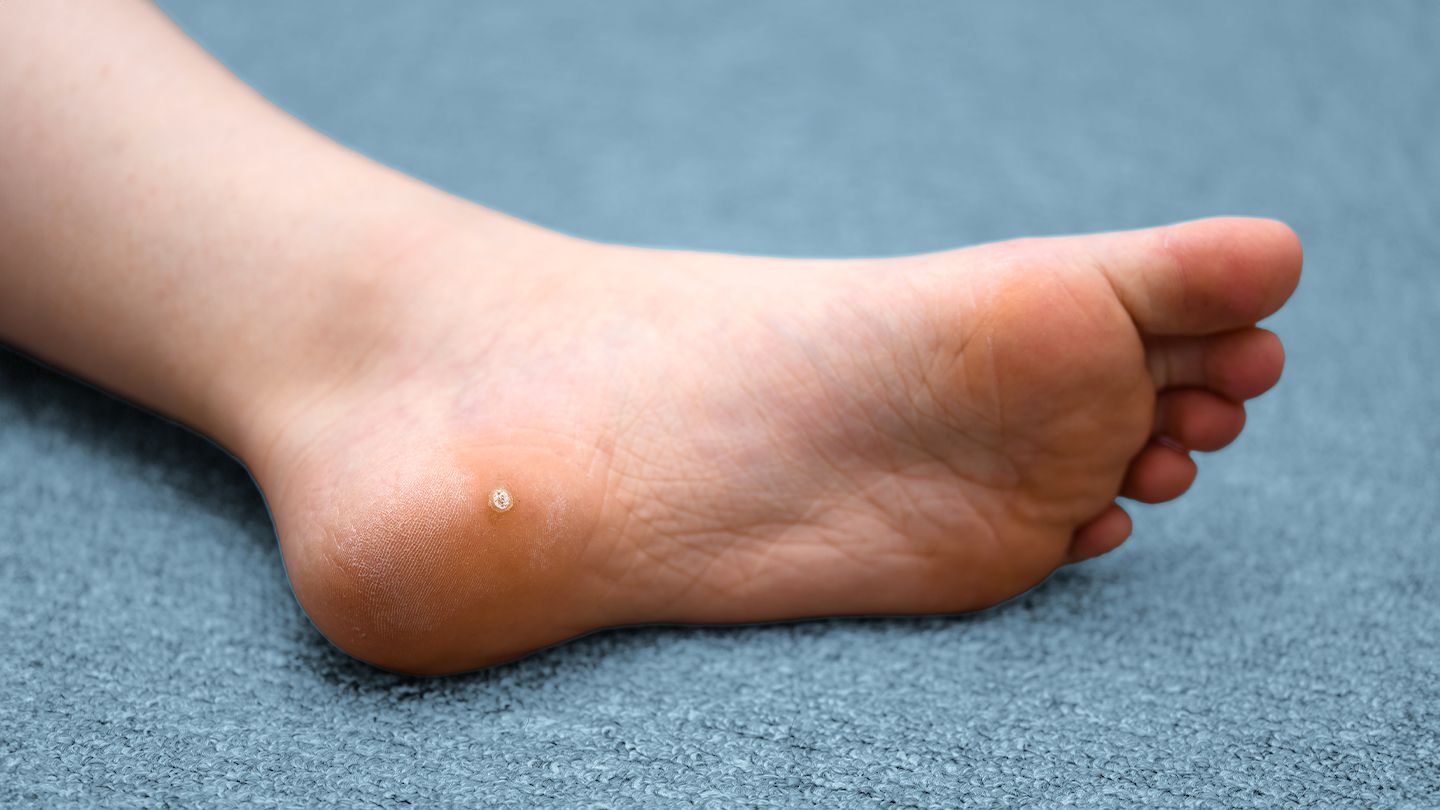Plantar warts, also known as verruca plantaris, are small, rough bumps that form on the soles of your feet from a skin infection with the human papillomavirus (HPV) . While they can cause significant discomfort or even pain when you walk, plantar warts are considered harmless or benign skin growths that do not impact your overall health. Plantar warts are one of the most common type of warts, affecting up to 14 percent of the population each year. If left alone, most warts go away within two years after your body has fought off the HPV infection, and there are numerous treatments to hasten the healing process.e60dc2a1-f33c-4a05-9b50-8e3e8e597629f47ea8ed-a07e-4b03-aaa4-e2b0cfb5f2a2
Types Types of Plantar Warts There are two types of plantar warts: solitary and mosaic plantar warts.e60dc2a1-f33c-4a05-9b50-8e3e8e5976295eeed757-4938-4766-9d0b-d6363e00efb6 Solitary Plantar Wart As its name implies, a solitary plantar wart is a single wart on the bottom of the foot. It often increases in size over time and can form additional, “satellite” warts nearby if the HPV infection spreads. Mosaic Plantar Warts When a cluster of several small plantar warts grow closely together, forming a kind of plaque, they’re called mosaic warts. They tend to be more difficult to treat than solitary warts.
Signs and Symptoms of Plantar Warts Symptoms Plantar warts aren’t always obvious at first and can closely resemble a callus. They begin as a small, round area of rough or thickened skin on the bottom of your foot (the “plantar surface”), which will gradually grow in size and deeper into the skin.e60dc2a1-f33c-4a05-9b50-8e3e8e5976294c729c8c-bf5e-4bd3-8404-bf05caa625c0 Other features of plantar warts include:e60dc2a1-f33c-4a05-9b50-8e3e8e597629eaa5cb47-8dbc-4263-870a-ca0675a89504 Discoloration, usually flesh-colored to yellow or gray-brown Pain, tenderness, or a sensation of a stone or swelling under the foot while walking or standing Pain or tenderness when squeezed Disruption in the natural skin lines and ridges of the foot’s skin Tiny black dots on the surface of the wart, which are clotted capillaries Pinpoint bleeding if cut (unlike calluses or corns) Plantar warts are often found in areas of increased pressure, such as the heels and balls of your feet, and they may multiply over time. If they grow closely together and coalesce to form a mosaic wart, they may appear as a thickened, “cobblestoned” plaque.
Causes and Risk Factors of Plantar Warts Causes Plantar warts are caused by HPV, of which more than 150 types exist. The most common types of HPV that cause plantar warts are:e60dc2a1-f33c-4a05-9b50-8e3e8e5976294badac89-f487-4eca-9978-4ca88cf75e13 HPV-1 HPV-2 HPV-27 HPV-57 You have an increased risk of developing plantar warts if you:e60dc2a1-f33c-4a05-9b50-8e3e8e59762912404c31-b726-4123-9dc0-315eeb48eca5 Walk barefoot in areas where HPV is abundant, such as communal showers, locker rooms, bathrooms, and swimming pools Pedicure your nails with improperly sanitized tools Have cuts, cracks, or weak spots in the skin of the feet Are in close contact with someone who has warts Have a history of warts Share unwashed socks or shoes
How Are Plantar Warts Diagnosed? Diagnosis A plantar wart diagnosis is usually straightforward, and is based on the wart’s appearance. To distinguish it from other similar skin lesions, such as corns and calluses, healthcare providers will look for signs that are indicative of plantar warts, particularly if the growth: Disrupts your natural skin lines and ridges Has a tiny black dot Bleeds when trimmed or shaved If an examination of the lesion on your foot doesn’t provide a clear answer (or if you’re already undergoing treatment but it doesn’t appear to be helping), your provider may conduct a biopsy by taking a tissue sample and examining it under a microscope. This will allow them to rule out other potential causes for the growth.e60dc2a1-f33c-4a05-9b50-8e3e8e5976293ff09cde-5145-4e20-b5f5-d80d26ea28df
Treatment and Medication Options for Plantar Warts Treatment Many plantar warts eventually go away on their own, without leaving a blemish or scar. But because warts can be painful or persistent, healthcare providers sometimes recommend treatment. There are many available treatments, which are generally less effective for people with compromised immune systems. When deciding whether to treat your plantar wart or which treatment to go with, note:e60dc2a1-f33c-4a05-9b50-8e3e8e597629f1620f8e-0483-425b-bc93-297f05c472d4 No treatment is known to be consistently effective for all people. Successful treatment of a wart does not prevent future warts, and warts often return after treatment. Few treatments treat the underlying HPV infection. Some treatments are painful and can leave blemishes. Complete wart removal requires repeated treatments. Salicylic acid, a topical medication that’s also used to treat acne, and cryotherapy with liquid nitrogen — which freezes the tissue — are the most common treatments for plantar warts. While these treatments are highly accessible, they generally have lower cure rates than other treatments.e60dc2a1-f33c-4a05-9b50-8e3e8e5976294fa8e295-8d68-4357-86f0-ce44555222ce Some other treatments include: Other types of acid, such as formic acid, glycolic acid, pyruvic acid, and citric acid Laser therapy, such as with a CO 2 laser and pulsed-dye lasere60dc2a1-f33c-4a05-9b50-8e3e8e597629b47b5b09-e4ef-4ec5-adb6-62714e839dc9 cantharidin (Ycanth), a topical chemical agent cantharidin-podophyllin-salicylic acid formulation Topical antivirals Immunosuppressant drugs injected into the wart Injected bleomycin, an antibiotic that is also used to treat several types of cancer 5-fluorouracil (Adrucil), a chemotherapy agent Minor surgery oral cimetidine (Tamaget)e60dc2a1-f33c-4a05-9b50-8e3e8e59762932980709-0e02-4718-aca0-dd5754e761cf zinc and nitric complex The effectiveness of these and other treatments vary between studies. For most treatments, patience is key, as they often require multiple sessions (except for treatments like surgery). Speak with your healthcare provider before attempting any treatment.
Prevention of Plantar Warts Prevention Some prevention tips include:e60dc2a1-f33c-4a05-9b50-8e3e8e597629be4a3db4-1552-43b6-8aac-d1f99427c261 Don’t share towels, shoes, socks, and other personal items. Wear footwear in communal areas like showers, locker rooms, and bathrooms. Wash socks after you use them. Keep your feet clean and dry, including by wearing breathable socks and shoes. Avoid touching other people’s warts. Receive the quadrivalent HPV vaccine. Promptly treat current warts. Throw out pumice stones and other exfoliating tools you’ve previously used on your plantar warts. Disinfect your shoes with sprays or wipes.
Lifestyle Changes for Plantar Warts Lifestyle Changes If you’re dealing with plantar warts, various prevention tips can also speed up recovery and prevent spread, such as: Wash and change socks after wearing them. Use dedicated foot tools on your warts and sanitize them after each use. Keep your feet dry and wear breathable shoes. Don’t go barefoot in communal areas. Use medications for your wart as instructed. Take over-the-counter pain-relief drugs like acetaminophen (Tylenol), ibuprofen (Advil), and naproxen (Aleve) for pain.e60dc2a1-f33c-4a05-9b50-8e3e8e59762970a1fd25-be57-4ec2-90a3-bc6df8005c12 Cover or bandage your wart while walking around barefoot to prevent irritating and spreading it. Some anecdotal reports suggest you can get rid of a wart faster by wrapping it in duct tape for several days to weeks before soaking it in lukewarm water and filing it down — but there’s little evidence this technique works.e60dc2a1-f33c-4a05-9b50-8e3e8e5976297355fe52-fa23-4a33-bc4a-4e229d9d351a
How Long Do Plantar Warts Last? Prognosis and Outlook Research suggests 65 to 78 percent of warts go away on their own within two years.e60dc2a1-f33c-4a05-9b50-8e3e8e597629e7ecf59d-d565-4549-946b-08ab17350a89 Treatment may significantly speed up recovery time and cure the wart, sometimes in just a few weeks.e60dc2a1-f33c-4a05-9b50-8e3e8e5976290d0fb8e3-f86e-4e13-b3fb-7f2c598763a4
Complications of Plantar Warts Complications Plantar warts are typically harmless, but they may cause minor complications, such as: Pain severe enough to affect the way you walk Self-consciousness Recurrence even after treatment Spread of warts on the foot and possibly to other parts of your body In rare cases, plantar warts may develop into a slow-growing cancer called verrucous carcinoma. This is seen most often in people who are immunocompromised (have a weakened immune system), such as those with HIV.e60dc2a1-f33c-4a05-9b50-8e3e8e597629be9f972f-662b-46f8-bd98-478878dd7cf4 If you develop a non-healing sore or ulcer on your foot, see your doctor for diagnosis and treatment.
Research and Statistics: Who Gets Plantar Warts? Research and Statistics Anyone can get plantar warts if infected with HPV. Research suggests they’re more common in:e60dc2a1-f33c-4a05-9b50-8e3e8e59762931c14b4c-2977-4440-8010-57b34694ad6b Children and adolescents, especially females Adult men White people Individuals with compromised immune systems, such as those with HIV or AIDS Athletes Manual laborerse60dc2a1-f33c-4a05-9b50-8e3e8e5976297bbf09ea-c921-4a79-a026-370b7a3e5d28 You may be more likely to get plantar warts during winter months.
Related Conditions Related Conditions Plantar warts are just one of many types of warts, which differ based on their cause (the specific HPV type), physical features, and location on the body. These include: Common warts Palmar warts, which are similar to plantar warts but occur on your palms (taken together, they are called deep palmoplantar warts) Flat warts Filiform warts, which usually occur on the face or necke60dc2a1-f33c-4a05-9b50-8e3e8e597629ce67d2ca-7a9a-44eb-b7a7-d33158670840 Genital warts Butcher’s warts, which typically form on the hands of people who handle raw meat or fish Focal epithelial hyperplasia, or Heck’s disease, referring to warts inside your mouth Cystic warts, which also tend to appear on the soles of the feete60dc2a1-f33c-4a05-9b50-8e3e8e597629d0ff6239-501c-471f-a107-2d140b254956 Subungual and periungual warts, which appear under and around the fingernails and toenails Plantar warts may be mistaken for corns or calluses, which are areas of hardened and thickened skin.e60dc2a1-f33c-4a05-9b50-8e3e8e5976296c6c0d51-f1ed-46c8-9421-43d65337f16a
The Takeaway Plantar warts are common and uncomfortable — but also treatable. They normally resolve on their own over time, and early intervention can reduce their duration and how much they impact your life. Preventive steps and lifestyle changes, especially protecting your feet in public places, go a long way toward keeping plantar warts at bay.
Resources We Trust Cleveland Clinic: Can Duct Tape Remove Warts?Mayo Clinic: Tuesday Q and A: Several Treatments May Be Needed to Eliminate Plantar WartsAmerican College of Foot and Ankle Surgeons: Plantar Wart (Verruca Plantaris)American Podiatric Medical Association: WartsAmerican Academy of Family Physicians: Warts and Wart Removal
Read the full article here
Leave a comment




